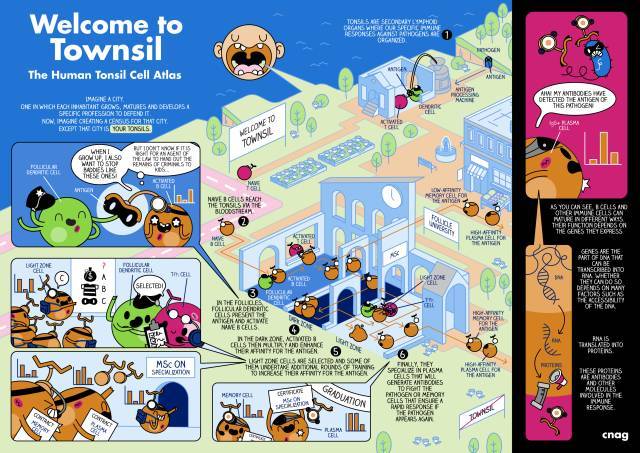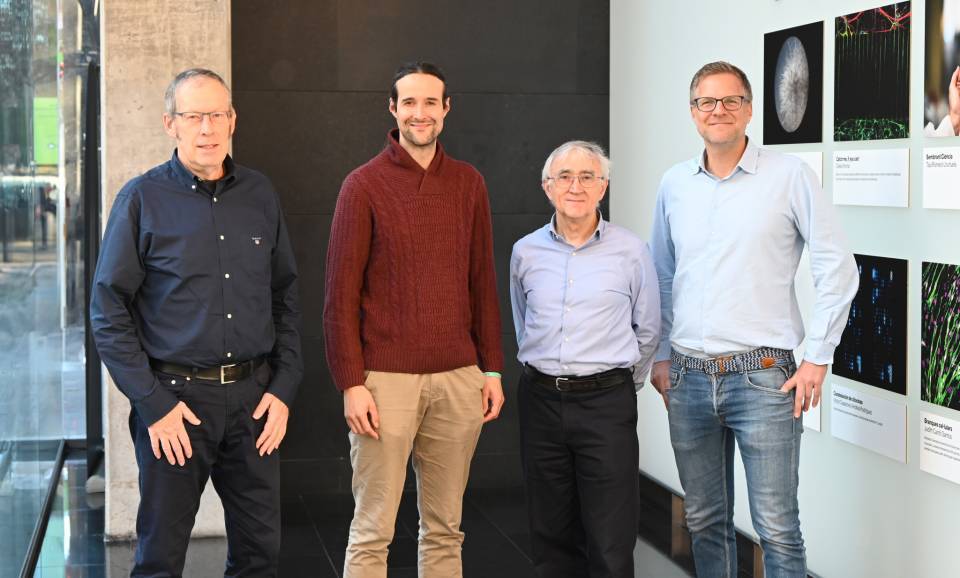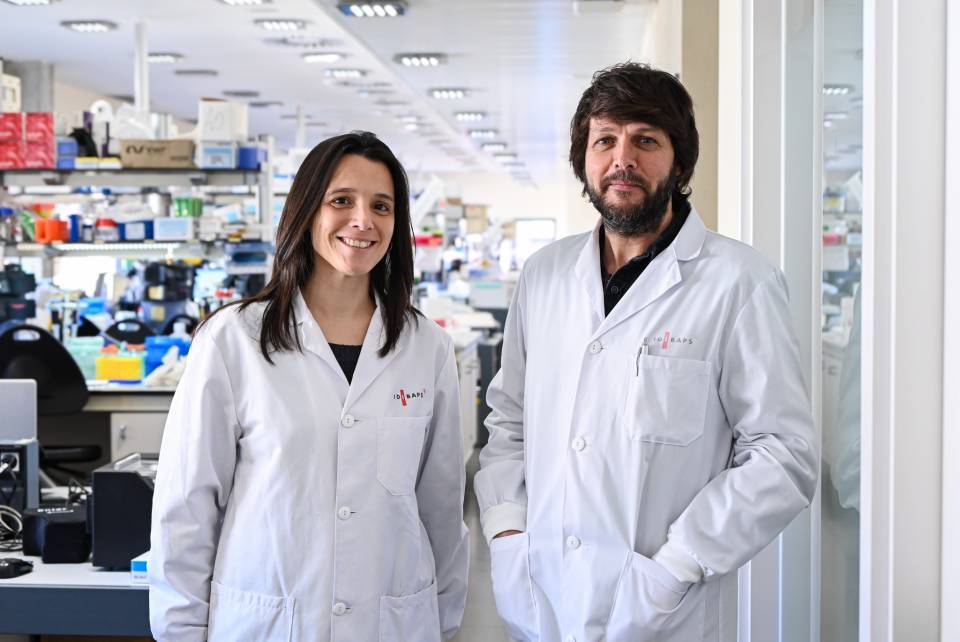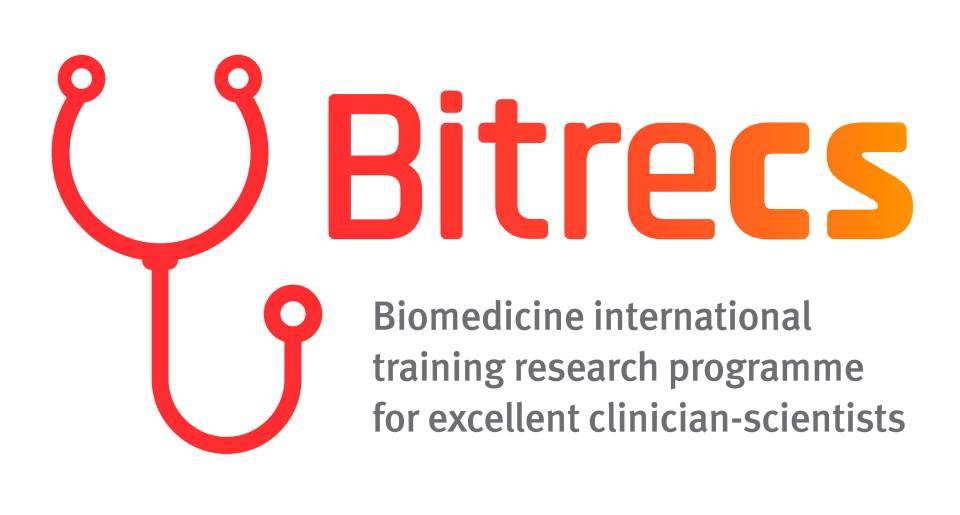The human body is made up of more than 37 billion cells, almost 5 times the number of humans on the planet. At a cellular level the human body is a highly organized structure that is still largely uncharted. Scientists of the Human Cell Atlas projects are now striving to decipher this universe of cells. A catalogue of how many types of cells are in our organs, their states, their locations and how they interact is key to understand how the organism is regulated and protected from disease. A map of cell types of lymphoid organs such as the tonsil, which regulate the generation of cellular immune responses, is invaluable to understand inflammatory diseases and cancer. Tonsils serve as an excellent model due to their accessibility and strategic localization at the intersection of the respiratory and digestive systems, where ingested or inhaled pathogens enter. Tonsils play a key role in organizing our immune defense and hence, there is a need to understand their cellular architecture in depth. This was the main motivation for the charting of the cellular atlas of the human tonsil, an international study recently published in the prestigious journal Immunity.
The international research was led from Barcelona, by the Centro Nacional de Análisis Genómico (CNAG) and the Institut d'Investigacions Biomèdiques August Pi i Sunyer (IDIBAPS), with the collaboration of a wide range experts from France, UK, Germany, Saudi Arabia, Switzerland, Australia and Spain, highlighting the Centro de Investigación Médica Aplicada (CIMA) from the University of Navarra. The study was coordinated by national references, such as Ivo Gut (director of CNAG and Biomedical Genomics Group Leader), Holger Heyn (Single Cell Genomics Team Leader at CNAG), Elías Campo (director of IDIBAPS and Molecular Pathology in Lymphoid Neoplasms Group Leader) and Iñaki Martín-Subero (ICREA professor and Biomedical Epigenomics Group Leader at IDIBAPS).
The study is the result of a large collaborative effort across an interdisciplinary team, encompassing: data collection from IDIBAPS; data processing from the Single Cell Genomics Team at CNAG, who ensured high data quality, and the analytical team led by Ramón Massoni-Badosa (CNAG), Sergio Aguilar-Fernández (CNAG), Juan C. Nieto (CNAG) and Paula Soler-Vila (IDIBAPS), in charge of the interpretation, annotation, and classification of cellular subtypes.
“Creating this high-resolution atlas of the human tonsil has been a monumental collaborative effort of all the investigators involved. It delivered many surprises which deepen our understanding of how secondary lymphoid organs function. The immune system is remarkable in its intricacy and beauty”, highlights Ivo Gut, coordinator of the project and director of CNAG.
The publication is the fruit of the BCLLatlas Project, an European initiative funded with 8 million euros, which aim is to resolve the genomic and epigenomic characteristics of B cell development and chronic lymphocytic leukemia, the most frequent adult leukemia in the Western world. This project represents the first results of the project, contributing to the Human Cell Atlas, an international Consortium formed by more than 1,500 institutes and 94 countries around the world with a main objective, which strives to create reference maps of all human cells.
New resource for the fight against leukaemia and lymphomas
The publication of this project includes the most comprehensive census of cell types forming the human tonsil, a resource of more than 556,000 cells, classified in 121 cell types.
The human tonsil is an excellent organ to study the interaction between innate and adaptative immune cells. While the former form our body's first defense barrier, the latter represent specialized immune cells that attack and destroy foreign invaders and keep a memory for future attacks. In the cellular universe, adaptive immunity is produced by a chain reaction of events of a large number of specialized immune cells. When pathogens enter the tonsil, they are processed by antigen presenting cells, which activate T and B lymphocytes to generate a targeted response to fight respective pathogens.
“We have been able to create a map, through the lenses of new technologies, the vast cellular universe hidden within the human tonsil. It is not a stable map but a rather dynamic and complex structure with multiple different cells that help each other to finally produce highly effective immune cells to fight against pathogens”, declares Iñaki Martín-Subero from IDIBAPS.
The research has allowed to identify, for first time, the wide range of heterogeneity of tonsillar cells and a better understanding of cell type regulation. For example, the study has found multiple tonsil-resident myeloid subtypes cells, established that the regulatory region surrounding BCL6 is locally active in T and B cells, and described the transcription factor SIX5 as a potentially novel regulator of plasma cell maturation. In short, the tonsil atlas is a valuable resource to uncover the complexity of the tonsil in greater depth and how it defends our body from attacks of pathogens. It also provides a blueprint for a healthy secondary lymphoid organ to be used as a reference to define disease-driving mechanisms, for example, in lymphoid neoplasia, such as chronic lymphocytic leukemia (CLL).
“This detailed map of immune cells provides an exceptional framework to better understand the development of malignant diseases such as lymphoid tumors. Furthermore, such a detailed description of healthy immune cells will be essential to improve current cellular immunotherapies, which are based on modulating the interaction between cells of our immune system and cancer cells”, informs Elías Campo, coordinator of the study.
Cutting-edge genomic technologies and a free access bioinformatic software
The result obtained has been possible thanks to cutting-edge genomic technologies, available at CNAG, the largest center for sequencing and genomic analysis nationwide and an international reference. In particular, for this research, the methodology applied has been the combination of cellular genomics techniques, such as single-cell transcriptome, epigenome, proteome and immune repertoire sequencing as well as spatial transcriptomic.
According to one of the coordinators of the study and Single Cell Genomics Team Leader at CNAG, Holger Heyn: "With the Tonsil Atlas, we contribute an organ to the Human Cell Atlas that is at the heart of our immune system. Moving forward, we integrate our atlas with other immune compartments, such as lymph nodes, to further decipher how immunity is built and conserved. The enormous complexity observed in the tonsil highlights again the amazing plasticity of immune cells, optimized over millions of years of evolution. Deciphering the underlying rules will allow unthinkable leaps in diagnostics and therapeutics, appreciating the immune system as universal clinical tool”.
CNAG has developed a software, HCATonsilData, with the aim of ensuring that the study is available for the research and clinical community. The program helps the users to access and download the analyzed data, enabling other professionals to take a step further in their research.
“Townsil”, the tonsil cellular atlas told through a comic
The cellular atlas of the human tonsil has been translated into a comic that narrates the adventures of a B cell in combating pathogens. Our main character resides in Townsil, together with the other cell types described in the research. In this city, which represents the major histological features of the tonsils, all its inhabitants grow, interact and mature until they develop a specific profession aimed at defending us against pathogens. These professions are determined by the genes they express, which are the part of DNA (deoxyribonucleic acid) that is transcribed to RNA (ribonucleic acid) and ultimately translated into proteins that determine the immune cell's function. All of this is narrated through our protagonist, who matures from a naive lymphocyte to become a specific plasma cell capable of secreting antibodies against the pathogens.


Study of reference
Ramon Massoni-Badosa et al., ‘An Atlas of Cells in the Human Tonsil’. Month, year. DOI: https://www.cell.com/immunity/fulltext/S1074-7613(24)00031-1.




